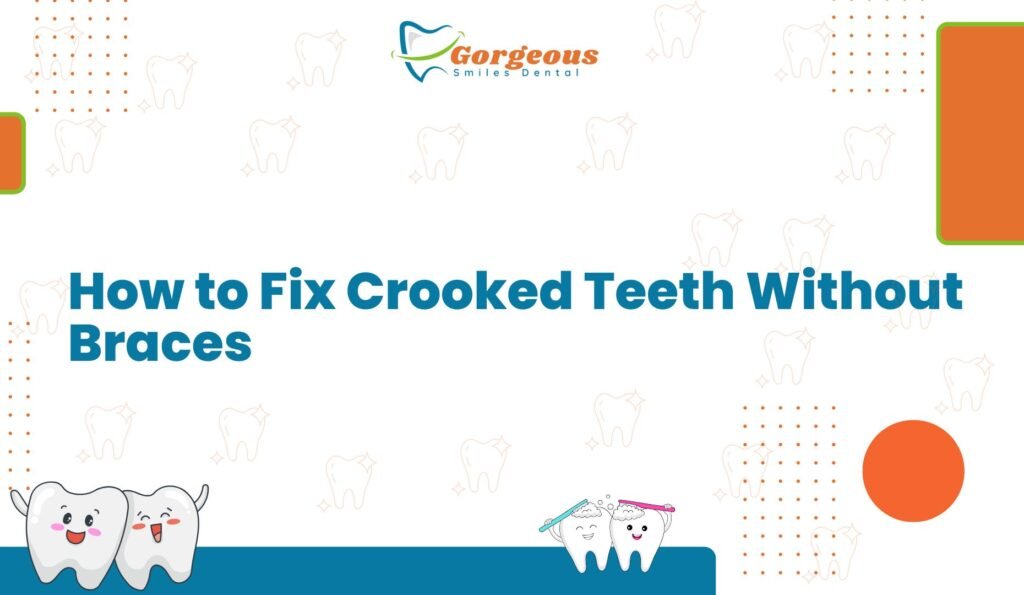How to Fix Crooked Teeth Without Braces

Crooked teeth can make you feel self-conscious when you smile. They can also affect chewing, speaking, and overall oral health. Many people think braces are the only option, but there are several modern ways to straighten teeth without traditional metal brackets. These options are comfortable, discreet, and fit easily into daily life. This guide explains every method in a simple, friendly way so you can understand what works best for you.
Understanding Why Teeth Become Crooked
Crooked teeth form for many reasons. It may be genetic, or it may develop over time because of daily habits. When you understand the cause, it becomes easier to choose the right treatment that does not require braces.
Genetics and Natural Jaw Growth
Many people inherit small jaws or large teeth. When the jaw doesn’t have enough room, the teeth crowd or shift. This natural imbalance is one of the most common causes of misalignment.
Childhood Habits That Affect Alignment
Thumb-sucking, long-term pacifier use, nail-biting, or tongue-thrusting can push teeth out of alignment. Even though these habits may stop later, the damage often remains.
Tooth Loss and Shifting
When you lose a tooth and leave the gap empty, nearby teeth drift into the open space. Over time, they may tilt or rotate, causing crookedness that worsens with age.
Poor Bite Alignment (Malocclusion)
A poor bite can change how the teeth fit together. This includes underbite, overbite, crossbite, or open bite. These issues often push teeth out of their natural position.
Can You Really Fix Crooked Teeth Without Braces?
The simple answer is yes. Many modern treatments straighten teeth without the look or feel of braces. These options use new-age orthodontic systems, cosmetic dental treatments, and even small adjustments that gently reshape the teeth. Some work faster than braces, and many are almost invisible.
Who Is a Good Candidate for Non-Braces Teeth Straightening?
You may be a good candidate if you have:
- Mild to moderate crooked teeth
- Small gaps
- Slight crowding
- Mild bite issues
- Good oral health
Severe alignment problems still need orthodontic braces, but most adults and teens with basic alignment concerns can choose alternatives.
Clear Aligners: The Most Popular Way to Fix Crooked Teeth Without Braces
Clear aligners are one of the best solutions for straightening teeth without metal brackets. They use custom transparent trays that gently move the teeth into place over time. They are comfortable, removable, and almost invisible.
How Clear Aligners Work
Clear aligners work in stages. Your dentist scans your teeth, creates a 3D model, and prints a set of custom trays. You switch to a new set every one to two weeks. Each tray applies small controlled pressure to shift the teeth.
Why Clear Aligners Are So Popular
People choose aligners because they offer:
- A discreet appearance
- No wires or metal
- Easy cleaning
- Removability during eating
- Shorter treatment time
They are ideal for adults and teens who want a clean, natural look.
Types of Clear Aligners
There are many brands, but the most common include:
- Invisalign
- ClearCorrect
- SureSmile
- At-home aligner kits (less recommended due to lack of dental supervision)
Dentist-supervised aligners are safer and more predictable.
Dental Veneers: Cosmetic Fix for Crooked Teeth
Dental veneers are thin shells bonded to the front surface of your teeth. They don’t move teeth, but they create the illusion of perfect alignment. Veneers are a cosmetic option that improves both shape and color.
How Veneers Help With Crooked Teeth
Veneers work best when the crookedness is mild. They can fix:
- Small rotations
- Slight overlaps
- Uneven teeth
- Gaps
They instantly change how the smile looks.
Types of Veneers
You can choose from:
- Porcelain veneers
- Composite veneers
- Minimal-prep veneers
- No-prep veneers
Porcelain is the strongest and most natural-looking option.
Who Should Choose Veneers?
Veneers are ideal if you want:
- Fast cosmetic results
- A perfect white smile
- Minimal orthodontic work
- A long-lasting solution
They are not recommended for severely crooked teeth or weak enamel.
Dental Bonding: A Fast Fix for Slight Crookedness
Dental bonding uses a tooth-colored resin to reshape uneven teeth. This method is similar to veneers but is cheaper and faster. It works best for people who need small enhancements.
How Bonding Works
The dentist applies a tooth-colored material, shapes it by hand, and hardens it using a special curing light. In one visit, the teeth can look straighter and more even.
When Bonding Is a Good Choice
Bonding is ideal for:
- Small chips
- Slight overlapping
- Mild gaps
- Uneven edges
It is not strong enough for major alignment changes but works well for light correction.
Contouring and Reshaping: A Simple and Painless Option
Tooth contouring is one of the simplest ways to improve crooked teeth. The dentist gently removes a tiny amount of enamel to even out irregular shapes. It is safe, painless, and quick.
What You Can Fix With Contouring
This option works for:
- Minor crowding
- Sharp edges
- Uneven lengths
- Overlapping tips
It cannot fix major misalignment but can make the teeth look straighter instantly.
Is Contouring Safe?
Yes, when done correctly. Only a small amount of enamel is removed. Your dentist will check your enamel thickness before treatment.
Lingual Braces: A Hidden Way to Straighten Teeth
Lingual braces are still braces, but they’re completely hidden because they sit on the inner side of your teeth. Many people choose them because they want orthodontic-level correction without visible brackets.
How Lingual Braces Work
Lingual braces use custom wires and brackets that attach behind the teeth. They move teeth the same way as regular braces but stay invisible from the front.
Who Should Consider Lingual Braces?
They work well for people who:
- Need stronger correction
- Want a hidden orthodontic system
- Are uncomfortable with removable aligners
- Have complex bite issues
Lingual braces may cause temporary tongue irritation, but most patients adjust within a few weeks.
Conclusion
Fixing crooked teeth without braces is possible, comfortable, and more accessible than ever. Today’s treatments give you choices based on your goals, whether you want discreet tooth movement, fast cosmetic results, or a full smile transformation. Clear aligners, veneers, bonding, contouring, and lingual braces each offer a different path to a straighter and healthier smile. The best option depends on how crooked your teeth are and what kind of results you want.
For mild to moderate cases, clear aligners are often the most effective and natural choice. Cosmetic options like veneers and bonding work well when the goal is to improve the appearance quickly. Contouring is ideal for small surface corrections. Whatever option you choose, a dental consultation helps you understand what will work best for your teeth, your jaw, and your lifestyle.
A straight smile supports better oral health, easier cleaning, and more confidence every day. If you’re ready to explore the safest and most effective alternatives to braces, reach out to a Dentist in Worcester, MA who can guide you with the right treatment plan.
FAQs
Can you really straighten teeth without braces?
Yes. Clear aligners, veneers, bonding, retainers, and lingual braces can all improve crooked teeth without traditional braces. The right option depends on how misaligned your teeth are.
Are clear aligners effective for adults?
Yes. Clear aligners work extremely well for adults because they are custom-made, discreet, and designed for predictable tooth movement when used correctly.
How long do non-braces treatments take?
It depends on the method. Clear aligners may take 6–18 months. Veneers and bonding often take only one or two visits. Contouring takes minutes. Lingual braces require several months.
Are veneers a good option for crooked teeth?
Veneers work well for mild crookedness, gaps, and uneven shapes. They improve appearance instantly but do not move the teeth physically.
Is dental bonding strong enough for crooked teeth?
Bonding helps reshape mildly crooked or uneven teeth. It’s ideal for small corrections, but it’s not designed for deeper alignment issues.
Can retainers fix crooked teeth on their own?
Retainers can fix only very slight alignment problems. They are better for maintaining results after treatment, not for major straightening.
Are at-home aligner kits safe?
They can be risky because there is no dentist supervision. Without X-rays and checkups, you may move teeth incorrectly or damage your bite.
Will my teeth stay straight after non-brace treatment?
Yes, as long as you wear your retainers as recommended and maintain good dental habits. Without retainers, teeth may shift again.
What is the fastest way to fix crooked teeth without braces?
Veneers and bonding offer instant cosmetic changes. Clear aligners offer fast orthodontic movement, especially for mild cases.
Does fixing crooked teeth improve oral health?
Absolutely. Straight teeth are easier to clean, reduce plaque buildup, lower gum disease risk, and help maintain an even bite.
Ready to book an appointment?
Book a consultation today or make an appointment using our convenient online appointment scheduler.

We’re committed to your safety.
Enjoy the flexibility of paying through monthly payments.

A discount plan available to keep you and your family healthy.
Others Article
At our dental practice, we prioritize compassion and empathy toward our patients. Please read our blog and articles for tips on maintaining oral health and learn more about our commitment to providing exceptional dental care with a personal touch.
